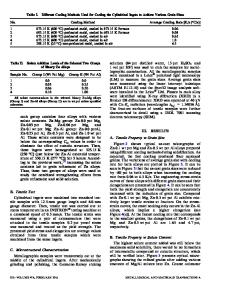Equal-channel angular pressing of commercial aluminum alloys: Grain refinement, thermal stability and tensile properties
- PDF / 10,108,668 Bytes
- 11 Pages / 612 x 792 pts (letter) Page_size
- 96 Downloads / 375 Views
CTION
EQUAL -channel angular (ECA) pressing is a processing procedure in which a material is subjected to intense plastic straining but without the introduction of any change in the cross-sectional dimensions of the sample.[1] This straining is achieved by simple shear by pressing the sample through a die containing two channels, equal in cross section, intersecting at an angle of ⌽.[2] An important characteristic of ECA pressing is that it provides the potential for refining the grain size of a material down to the submicrometer or nanometer range.[3,4] Previous reports have provided a detailed description of the microstructural characteristics associated with the ECA pressing of high-purity aluminum[5,6] and they have demonstrated that homogeneous microstructures of ultrafine grains may be achieved most readily when using a die with an internal angle of ⌽ ⯝ 90 deg.[7] Equal-channel angular pressing has an important advantage over processing by standard powder-metallurgy procedures because it may be applied directly to bulk samples prepared by ingot metallurgy, thereby avoiding any problems associated with residual porosity.* *The terms equal-channel angular pressing (ECAP) and equal-channel angular extrusion (ECAE) are used interchangeably in the literature on this topic. An important requirement of this procedure is that the cross-sectional dimensions of the test sample remain unchanged during processing so that, in practical terms at least, there is no extrusion of the material through a confining aperture. For this reason, the term ECA pressing appears to provide a more accurate description of the straining process and therefore it will be used exclusively in this article.
A reduction in grain size to the submicrometer level has two significant advantages. First, there is an increase in the tensile strength through the Hall–Petch relationship at low temperatures[8,9] with little or no corresponding reduction in the overall ductility. Second, if the ultrafine grains are stable at temperatures where diffusion is reasonably rapid, there is the possibility of achieving superplasticity at very high strain rates: there have been several recent reports of this effect using cast Al-based alloys.[10–13] Although it is now generally recognized that ECA pressing has a potential for utilization in industrial applications, only a limited number of reports describe the ECA pressing of commercial aluminum alloy.[4,10,11,14–25] Furthermore, although economic considerations in industry favor the development and use of ECA pressing at room temperature, most of the investigations reported to date describe experiments where the ECA pressing was performed at an elevated temperature and the as-pressed samples were subsequently tested at high temperatures. The present investigation was designed to address this deficiency. Specifically, the investigation was initiated with two objectives. First, to investigate the feasibility of achieving significant refinements in the grain sizes of commercial aluminum alloys through the use of the
Data Loading...











